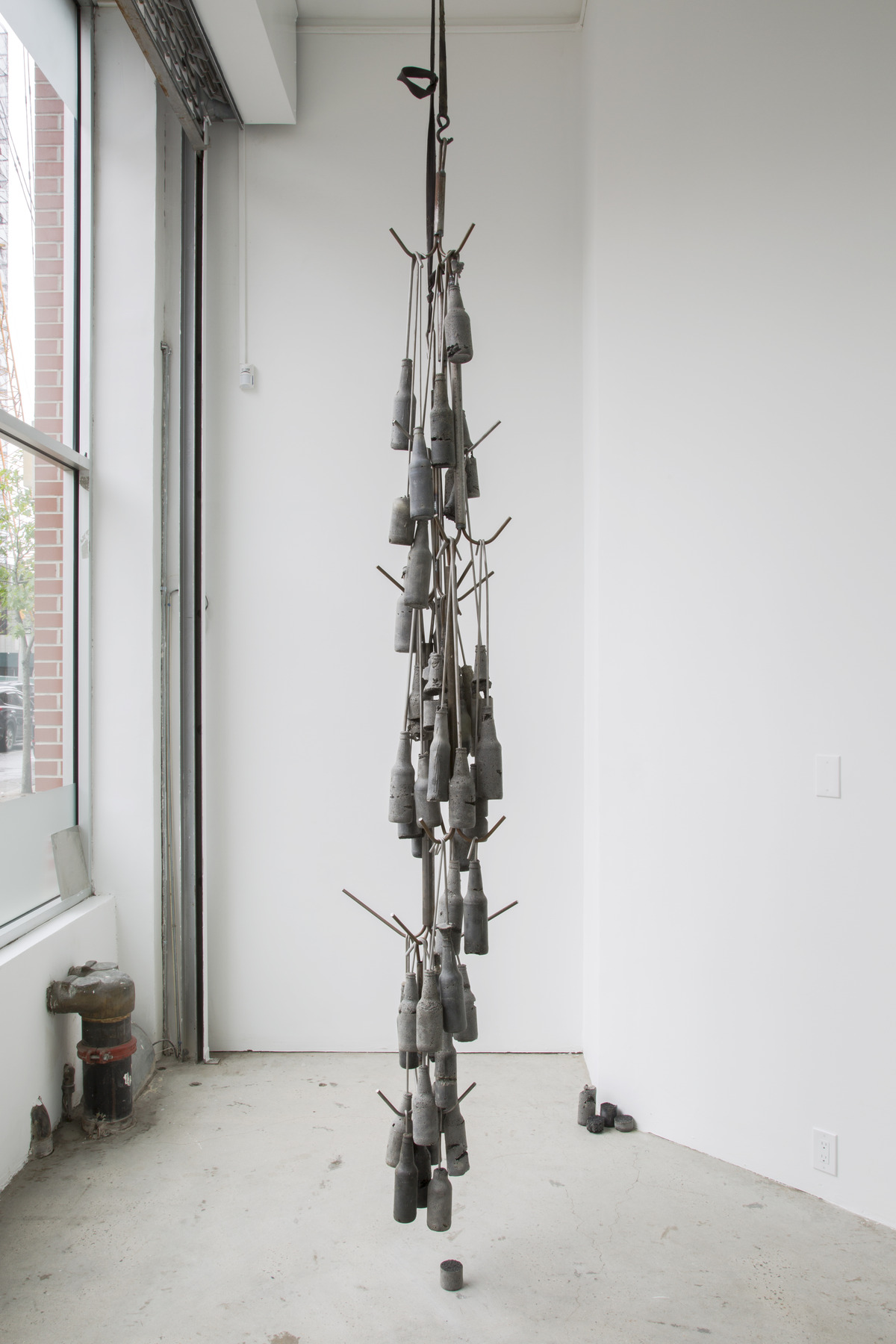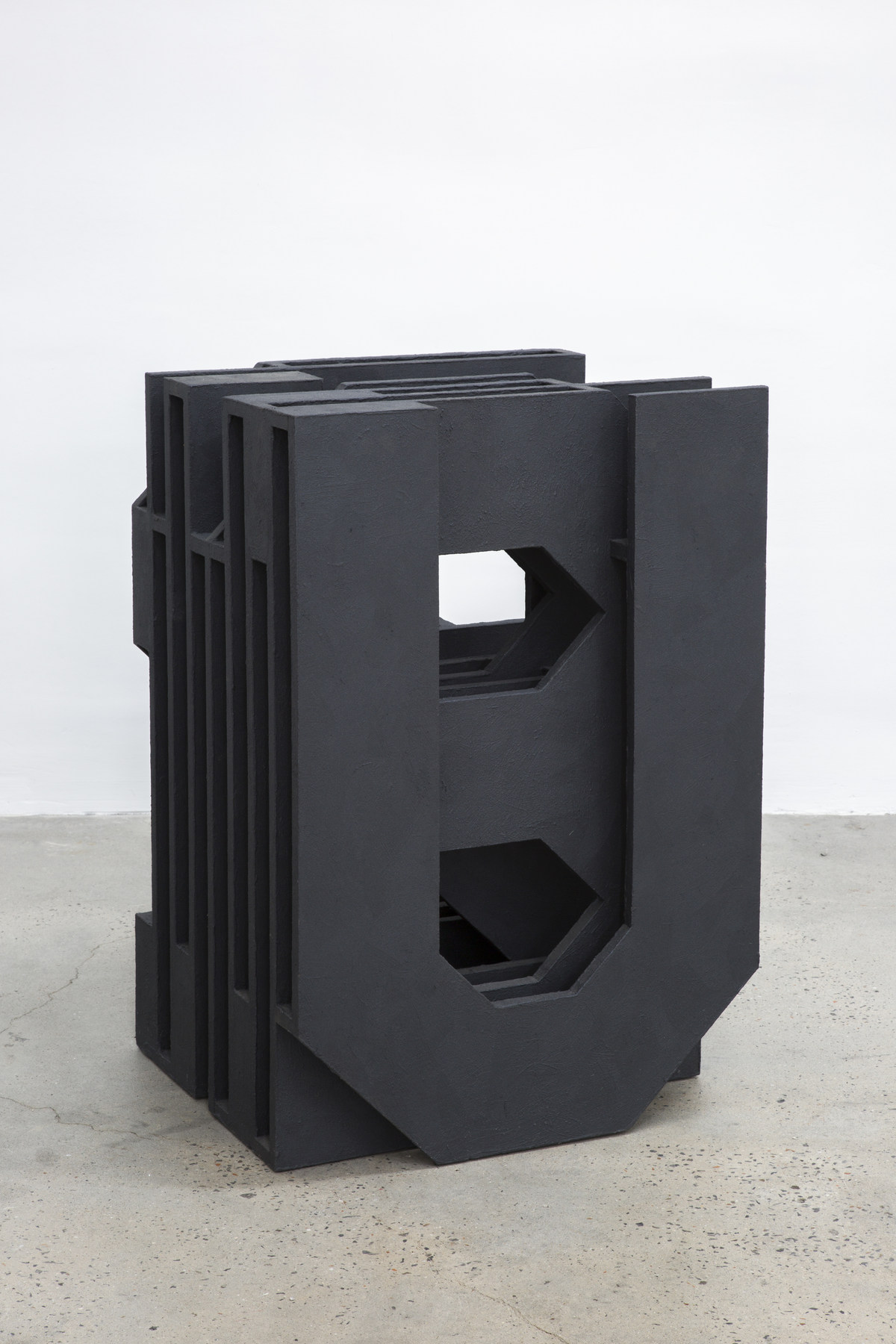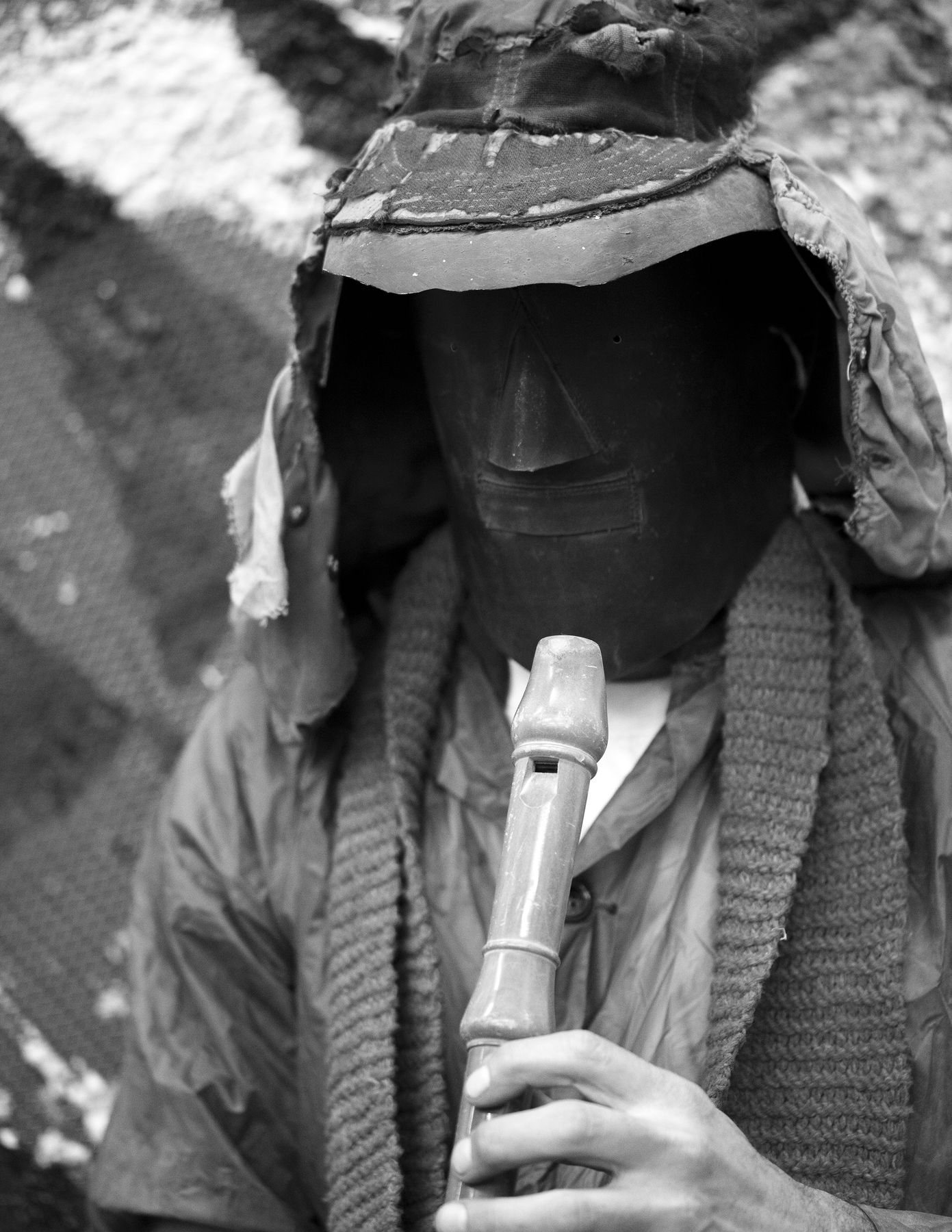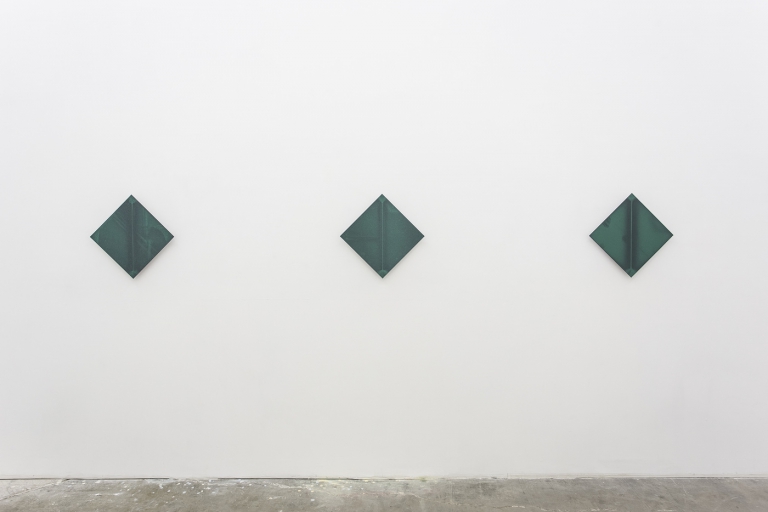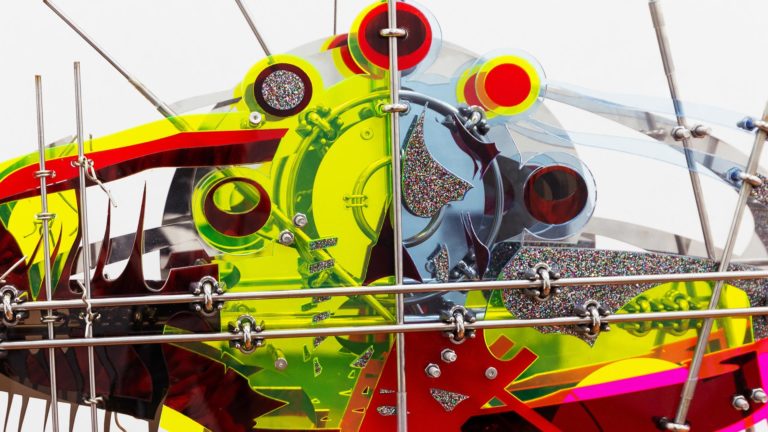Artist: Nick van Woert
Exhibition title: Organ Donor
Venue: GRIMM, New York, US
Date: June 2 – July 16, 2017
Photography: all images copyright and courtesy of the artist and GRIMM, New York
When Theodore Kaczynski, the infamous “Unabomber” left his career as a mathematician at Berkeley to move to Lincoln, Montana in 1971, he built himself a replica of Henry David Thoreau’s simple cabin on Walden Pond. Like the famous American philosopher-writer, he wanted a pared down life closer to nature. Unlike Thoreau, while eschewing modern comforts such as running water, he began a lone wolf campaign to attack industrialized, technological society using homemade bombs. He made these powerful weapons from everyday material sourced from hardware stores along with a basic set of tools. In 2011, the artist Nick van Woert purchased Kaczynski’s tool set and clothing from an online police auction; he cast the items in bronze using one-off sand molds of the objects and included the casts in a work titled, Improvised Munition (2011). Van Woert latched onto both Kaczynski and Thoreau as well as other counter-cultural, radical environmentalist figures such as MOVE, the Earth First movement, and Luddites who fought to preserve not only the natural environment but also a way of life that sought to be in concert with nature rather than dominate it through technological means. Educated first as an architect before becoming an artist, in coincidental symmetry to Kaczynski’s cabin, van Woert built a to-scale, architectural replica of the house where MOVE, a group of radical black-liberation, hunter-gatherers, lived in Philadelphia until it was firebombed by police in the 1970s.
Since his first solo exhibition in 2010, Van Woert has made typically large scale, mixed media sculptures, wall works, and paintings from quotidian materials. His interest in radical environmentalism is not expressed through his lifestyle, or a retreat to nature —he grew up in Reno, Nevada and today has a studio in the Greenpoint neighborhood of Brooklyn. Instead, one can locate an approach to thinking and working in concert with the immediate environment, immediate materials, and considering his own contemporary urban landscape and the ubiquity of artificial materials such as Muscle Milk and Kool-Aid as a recent departure from a history of what he terms more “monolithic” materials like stone and wood. In the late 60s, radical environmentalists transformed everyday, artificial materials into weapons in an attempt to preserve the American West: they poured sugar into gas tanks and mixed hair gel with chlorine to burn billboards. Those various materials signify the comforts of modern life: wealth, leisure, vanity, vacation—yet they can be mixed or altered, and suddenly they turn violent. These materials, produced through modern technological advances and almost never spoil, subconsciously satisfy a human desire for immortality that may only become more extreme as technology and time progresses.
Van Woert’s approach to materials is best epitomized in an early work, Haruspex (2010). Van Woert took a broken fiberglass cast of a classical Roman human statue and used urethane and various materials to build it up from hip to the height of where a head may have been using trash collected from the empty lot next to his studio. The statue, standing contrapposto next to a tree stump, appears to have a colorful growth of geological layers like some sort of petrified vision of what our society has left behind: cigarette butts, broken beer glass, Doritos bags, etc. compressed like a guide to a future landscape that has digested and eroded all of our artificial materials.
A haruspex is a religious figure in ancient Roman society who would cut open animals to reveal and interpret omens from their entrails. Ancient land surveyors would use information gathered by a haruspex about the health of the animals in a particular place to determine whether or not to build in that area. In Van Woert’s eponymous work, he draws a relationship between himself, as an artist, and this archaic figure. The work betrays an approach to the material world which seeks to go beyond the surface, digging deeper for the true, often ugly reality always present in everyday life, yet just beyond perception, even when hidden in plain sight. This present exhibition is titled after a new, central work in the exhibition, Organ Donor (2017). It is a steel stage or arena with a central steel grid, in which smaller sculptures and materials pass through and are transformed by the larger sculptural body. Like the entrails of an animal, the objects are presented like mysterious and coded omens about contemporary life. The artist has drawn a relationship between his Haruspex sculpture and the tradition of landscape painting. Subsequent works such as Erratic (2012), continues his experiment with geological layers. Long, crystal clear acrylic rectangular boxes are stacked like building material, forming an architectural slice that suggests it is or was once part of a larger building. The artist filled each box with everyday materials such as hair gel, aluminum foil, charcoal, sheetrock, lotion, Coca-Cola, Colon Cleanse, and other such items sourced from hardware and grocery stores. Mysteriously, he also included an aluminum cast of Kaczynski’s flute (it was among the lot of “tools” he purchased). In general, the works are less like traditional sculptures which explore traditional mediums or techniques than a sort of choreography of everyday life, rearranged and transmuted such that we are forced to examine it anew, as if we are chancing upon it, grasping for clues about today’s society and its strange rituals, attraction to artifice, and a sort of symbiosis with a chemical ecology.
The artist’s interest in landscape evolved and became more consciously referential as he titled a series of flat, rectangular, monochromatic works, composed mainly of cat litter, Landscape Paintings (2013), and hung them on the wall. At the same time, the works continue a haruspex line of inquiry, presenting a material which registers, and is used to absorb and neutralize the odor of housecat urine. Human sensation of the scent of cat urine has to do with their own biological make up, and its relationship to the pheromones contained in the urine. Those of us exposed to certain parasites as children, may actually be drawn to the scent rather than repelled by it. Cat litter is designed to hide the scent entirely and by extension, the notion that we are porous beings, shaped by our environments no matter how artificial they have become. What sort of omens about the health and future of our species might a contemporary haruspex divine from examining our insides? And how has our landscape and our homes, filled with off-gassing plastic and chemicals left its mark in our anatomy? These works can also be seen as a portrait of contemporary man, as the materials we created and which shape our world become a mirror image of the self. Likewise, as landscapes, they are not so much a depiction of a space, traditionally untouched and natural, but a conceptual consideration of how everyday materials, turned on their head, can register life through a vocabulary that brings us closer to what is really going on in society, both in and out of cities. These artificial materials unknowingly regulate our perception of the world around us and reinterpret what it means to be closer to nature.
Nick van Woert (b. 1979, Reno, NV) is a Brooklyn based artist. He received his MFA from Parsons in 2007 and completed residencies at Zabludowicz, in Sarvisalo, Finland; and at The Edward Albee Foundation in Montauk, New York. His work has shown widely, both nationally and abroad, including recent museum exhibitions at the Gemeentemuseum Den Haag in The Hague, Netherlands; and at MAMbo, the Museum of Modern Art in Bologna, Italy. Solo gallery exhibitions include GRIMM in Amsterdam; Yvon Lambert in Paris and New York; L&M in Los Angeles; and Moran Bondaroff in Los Angeles. Upcoming exhibitions include GRIMM, New York in June and Patron Gallery, Chicago in September 2017.
Nick van Woert, Intoxicated, 2017, Steel, coal slag and plastic, height: 112 in
Nick van Woert, Untitled, 2017, North American Pine and acrylic paint, stainless steel frame, 84 1/4 x 56 3/4 x 2 in
Nick van Woert, These are Weapons IV, 2017, White bronze, spray paint, 3 parts Various dimensions
Nick van Woert, They Lived Outside, 2017, Aluminum, cat litter, steel and leather in stainless steel frame, 24 parts, Frame: 84 3/4 x 55 x 4 1/4 in
Nick van Woert, A Bicycle Pump Makes A Handy Nightstick When Necessary, 2017, Silkscreen, spraypaint and coal slag on panel, unique, 35 3/4 x 23 3/4 x 1 3/4 in
Nick van Woert, They Blocked The Roads, 2017, Cat litter, tar paper, kool-aid, mesh, screws, plywood, spray paint, one shot paint, steel frame, Frame: 84 x 96 x 3 in, Cut-out: 78 3/4 x 86 x 2 in
Nick van Woert, Über Alles, 2017, Plywood and iron oxide paint, 35 x 21 3/4 x 21 3/8 in
Nick van Woert, From The Shed, 2017, Zinc, steel, t-shirt, 13 x 17 x 4 in
Nick van Woert, Untitled, 2016, Electroformed copper on plastic statue, 11 3/4 x 7 3/4 x 5 in
Nick van Woert, North Pond Hermit, 2017, Electroformed copper on plastic statue, 11 1/2 x 5 1/2 x 3 in
Nick van Woert, Axe, 2017, Melted bronze statue, wood, 18 x 7 x 1 in
Nick van Woert, Caltrop (Steel), 2017, Lambda print on panel, unique, 14 x 11 in
Nick van Woert, 3 Finger Strike, 2017, Sikscreen print, spray paint on panel, unique, 48 1/8 x 35 7/8 in
Nick van Woert, They Cracked The Dam, 2017, Cat litter, tar paper, kool-aid, mesh, screws, plywood, spray paint, one shot paint, steel frame, Frame: 84 x 96 x 3 in, Cut-out: 95 x 72 1/2 x 2 in
Nick van Woert, Him as Me, 2017, C-print on panel, 10 x 7 1/2 in
Nick van Woert, They Spiked The Trees, 2017, Cat litter, tar paper, kool-aid, mesh, screws, plywood, spray paint, one shot paint, steel frame, Frame: 84 x 96 x 3 in, Cut-out: 76 x 42 x 2 in
Nick van Woert, Us or Them, 2017, Coals slag, steel, plywood, spray paint, ink and burned wood, Various dimensions
Nick van Woert, These are Weapons I, 2017, White bronze, spray paint, 16 parts, Various dimensions
Nick van Woert, They Burned The Billboards, 2017, North American Pine and acrylic paint, stainless steel frame, 96 1/2 x 66 3/4 x 2 in
Nick van Woert, Organ Donor, 2017, Steel, white bronze, Various dimensions
Nick van Woert, Organ Donor, 2017, Steel, white bronze, Various dimensions
Nick van Woert, Organ Donor, 2017, Steel, white bronze, Various dimensions







